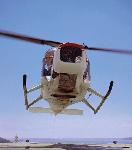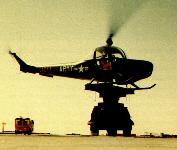
Описание
Страна : США
Год : 1953
Вертолет
Легкий транспортный вертолет с одним пилотом
Cessna CH-1 Skyhook (H-41 Seneca)
Компания "Cessna" некоторое время предпринимала попытки войти на рынок вертолетов - в марте 1952 года она приобрела компанию "Seibel Helicopter Company", и летом того же года специалисты "Cessna" приступили к работам над своим первым вертолетом, представлявшим собой фактически переработанный вариант модели Seibel S-3, выполнившей первый полет еще в 1947 году. Опытная машина совершила первый полет в июле 1953 года, а в июле 1954 года в воздух поднялся уже прототип вертолета Cessna CH-1 Skyhook, представлявшего собой легкий четырехместный вертолет стандартной для того времени конструкции, с двухлопастными несущим и рулевым винтами. Отличительной особенностью вертолета стал установленный в носовой части двигатель - разработчиком был выбран двигатель с воздушным охлаждением FSO-470-A, мощностью 260 л.с., связанный с несущим и рулевым винтами посредством простой трансмиссии с тремя и двумя редукторами соответственно. CH-1 имел цельнометаллическую конструкцию, кабина была рассчитана на двух человек (пилот и пассажир), располагавшихся плечом к плечу, а шасси - неубираемое лыжное (полозковое).
Следом за базовым вариантом последовала улучшенная модификация CH-1B, более совершенная в конструктивном и аэродинамическом плане, которая привлекла уже внимание Армии США, заказавшей для проведения всесторонних испытаний партию из 10 таких вертолетов, получивших обозначение YH-41 Seneca.
Для гражданского рынка была разработана модификация CH-1C, отличавшаяся кабиной на четырех человек, увеличенным запасом топлива и приборным оборудованием, позволявшим выполнять полеты в любых метеоусловиях. Впрочем, программа была вскоре закрыта.
ТАКТИКО-ТЕХНИЧЕСКИЕ ХАРАКТЕРИСТИКИ
Cessna CH-1C Skyhook
Тип: легкий транспортный вертолет с одним пилотом
Силовая установка: один четырехцилиндровый ПД Continental FSO-526-A мощностью 270 л. с. (201 кВт)
Летные характеристики: максимальная скорость на уровне моря 196 км/ч; крейсерская скорость на оптимальной высоте 193 км/ч; скороподъемность до высоты 2440 м - 314 м/мин; набор высоты 3050м-за 10 мин 16 с; статический потолок с учетом влияния земли 2925 м; дальность 644 км
Масса: пустого 944 кг; максимальная взлетная 1406 кг
Размеры: диаметр несущего винта 10,67 м; длина, при лопастях, ориентированных вперед-назад, - 13,00 м; длина фюзеляжа 8,97 м; высота 2,57 м; площадь, ометаемая несущим винтом, - 89,38 м!
Полезная нагрузка: до трех пассажиров или 227 кг груза
- Описание
Фотографии
-
Aviation Historian 3 / N.Stroud - Cessna's Whirlybird
A superb photograph by JIM LARSEN of one of Seattle Helicopter Airways’ Cessna CH-1C Skyhooks landing on a rooftop in the shadow of the city’s brand new landmark, the Space Needle, during the 1962 Seattle World’s Fair.
-
Aviation Historian 3 / N.Stroud - Cessna's Whirlybird
A Seattle Helicopter Airways Cessna Skyhook alights on a rooftop at the World’s Fair in 1962.
-
Aviation Historian 3 / N.Stroud - Cessna's Whirlybird
One of the Seattle Helicopter Airways (SHA) Skyhooks works the crowds at the Seattle World’s Fair, also known as the Century 21 Expo, during April to October 1962. The fair represented an excellent promotional opportunity for Cessna to extol the virtues of vertical flight in urban landscapes, and SHA’s fleet of CH-1Cs did a roaring trade during the six-month show.
-
Мировая Авиация 86
Возможности вертолета CH-1 были наглядно продемонстрированы в 1957 году, когда на нем были установлены три рекорда, включая рекорд высоты в двух весовых категориях (9252 м).
-
Aviation Historian 3 / N.Stroud - Cessna's Whirlybird
Регистрационный номер: N5156 [7] The second prototype CH-1, N5156, demonstrates the type’s versatility in a Cessna publicity shot. This aircraft was bare metal with emerald green upper surfaces and a tapering black cheatline which ran from the nose to the aft fuselage.
-
Aviation Historian 3 / N.Stroud - Cessna's Whirlybird
Регистрационный номер: N5156 [7] Another promotional shot of the second prototype CH-1, N5156. The first prototype, N5155, was originally built without the horizontal stabiliser on the aft fuselage and was much tested before one was fitted. All subsequent CH-1s were fitted with the stabiliser, which was modified a number of times during the type’s development.
The Cessna CH-1 helicopter has a gross all-up weight of 3.000 lb. At this weight, with a 260-h.p. Continental engine, it has a cruising speed of 100 m.p.h. over a range of 270 miles. Time to 10,000 ft. is 9 min. 27 sec.; hovering ceiling at 3,000 lb. is 11,000 ft.; rotor diameter is 35 ft.; fuselage length 32 ft. 1 in. -
Aviation Historian 3 / N.Stroud - Cessna's Whirlybird
Регистрационный номер: N5146 Production CH-1C Skyhook N5746 “four up” over Wichita in a slight variation of the production colour scheme. Note the the large horizontal stabiliser, which is of constant chord, in contrast to that of the YH-41, which had a swept leading edge.
-
Авиация и Космонавтика 2008-03 / Е.Ружицкий - История вертолетных рекордов (5)
Легкий многоцелевой вертолет YH-41 "Сенека"
-
Air Pictorial 1956-09
Регистрационный номер: N5156 [7] CESSNA CH-1A - First picture to be released of the new four-seat Model CH-1A (N5156), now in production at Prospect, Wichita, Kansas. This all-metal helicopter is essentially the same as the first two-seat prototype. the CH-1, which flew in July 1953. In turn, the CH-1 was developed from the Seibel Helicopter Company's S-4A Skyhawk (U.S .Army YH-24) and the S-4B of 1951 - Seibel being absorbed by Cessna in March 1952. Features of the CH-1A include the 360-degree vision "car-type" canopy; high-mounted tail rotor, and the nose-siting of t he 260-h .p. Continental FSO-470-A flat-six, aircooled motor. The FSO-470-A engine is supercharged to provide 260 h.p. from sea-level to 10,000 ft . at an a.u.w. of 3.000 lb., with cruise of 100-120 mp.h ., and range 290 miles . Rotor diameter 35 ft ., length (overall) 42 ft. 8 in .
-
Aviation Historian 3 / N.Stroud - Cessna's Whirlybird
Регистрационный номер: N5156 [7] Every home should have one - the second prototype CH-1, N5156, in yet another colour scheme, demonstrates the helicopter’s ability to transport passengers direct to the doorstep of a residence or country club. Despite Seibel and Cessna’s best efforts the Skyhook was a doomed concept and has virtually no profile in the company’s official history.
-
Aviation Historian 10 / B.Taghvaee, G.-R.Rahbaryan - The Shah's Skyhooks
Cessna’s sole venture into the rotary-wing market, the CH-1 Skyhook was conceived as a predominantly civil four-seat aircraft capable of delivering businessmen into the heart of the city. Ten examples entered service with the US Army as the YH-41 Seneca during 1957-58; the Iranian MAP examples were designated as UH-41As.
-
Aviation Historian 3 / N.Stroud - Cessna's Whirlybird
Регистрационный номер: N5156 [7] On September 13, 1955, Jack Zimmerman flew N5156 to Pike’s Peak in Colorado, where he flew the US Army’s Maj Gen John G. van Houten and Capt Knowles from nearby Fort Carson on a series of flights, one reaching 17,600ft.
-
Air Pictorial 1956-12 / Air Pictorial's photo-review
Регистрационный номер: N5156 [7] CESSNA YA-41-CE (temporarily registered N5156) is the newest U.S. Army Aviation two/four-seat A.O.P. currently undergoing evaluation trials. The YH-41 illustrated is actually the first prototype which was recorded in civilian guise in the September Air Pictorial.
-
Aviation Historian 3 / N.Stroud - Cessna's Whirlybird
Регистрационный номер: N5156 [7] The hardworking N5156 in US Army uniform; it never joined the Service but was painted for promotional purposes at the time of the Army’s order for ten YH-41s in the spring of 1956. Note the larger horizontal stabiliser placed further aft on the fuselage, as adopted on the CH-1B.
-
Aviation Historian 3 / N.Stroud - Cessna's Whirlybird
Fitted with the more powerful Continental O-526 engine, the YH-41 Seneca entered service with the US Army in September 1957, 56-4237 being the first to be delivered after a series of acceptance flights made by Lt A. E. Lush.
-
Aviation Historian 10 / B.Taghvaee, G.-R.Rahbaryan - The Shah's Skyhooks
1st Lt Gholam-Reza Rahbariyan (furthest left) helps unload supplies from Cessna UH-41A “201” during a Red Lion and Sun Society flood-relief operation at Gorgan and Gonbad-e Kavus in 1964.
-
Aviation Historian 3 / N.Stroud - Cessna's Whirlybird
A previously unpublished photograph of one of the UH-41As sent to Iran as part of the USA’s Military Assistance Program. It is believed that five examples served in Iran, although this is unconfirmed.
-
Aviation Historian 10 / B.Taghvaee, G.-R.Rahbaryan - The Shah's Skyhooks
Gholam-Reza Rahbariyan supervises the changing of the main rotor of UH-41A "203” while standing in the cockpit. The UH-41A was powered by a 270 h.p. Continental FSO-526A horizontally-opposed six-cylinder engine mounted in the nose.
-
Aviation Historian 10 / B.Taghvaee, G.-R.Rahbaryan - The Shah's Skyhooks
1st Lt Rahbariyan (right) and a Gendarmerie colleague during Red Lion and Sun Society flood-relief operations in 1964. The Skyhook was the first helicopter to be certificated for flying under Instrument Flight Rules (IFR) conditions, although the IIGAU UH-41As were seldom called on to do so.
-
Aviation Historian 10 / B.Taghvaee, G.-R.Rahbaryan - The Shah's Skyhooks
Gholam-Reza Rahbariyan (centre) beside one of the UH-41 As with a Dutch royal reporter (right) and photographer at Shiraz, the capital of the Fars Province, during a visit to the ruins at Persepolis by Princess Beatrix of The Netherlands in October 1963.
-
Aviation Historian 10 / B.Taghvaee, G.-R.Rahbaryan - The Shah's Skyhooks
Hamid Bayat (right) was the IIGAU chief mechanic and is seen here with one of the UH-41As at Shiraz Airport in 1967. In the background is a Douglas C-47 of Iranian airline Air Taxi Co, which began operations in 1958, becoming part of Pars Air in 1970 before the company’s name was changed to Iran-Aseman Airlines in 1980.
Другие самолёты на фотографии: Douglas DC-3 / C-47 Skytrain/С-53 Skytrooper / Dakota - США - 1935
-
Aviation Historian 10 / B.Taghvaee, G.-R.Rahbaryan - The Shah's Skyhooks
The majority of the photographs from Col Rahbariyan’s personal albums accompanying this feature are previously unpublished, images of the float-equipped IIGAU UH-41A having been particularly elusive up until now. Only one IIGAU example, “205”, was fitted with the floats, which must have considerably degraded performance.
-
Aviation Historian 3 / N.Stroud - Cessna's Whirlybird
Регистрационный номер: N5157 An extremely rare photograph of Capt James Bowman landing the heavily modified N5157 on its trolley (the undercarriage having been removed) following its record-setting high-altitude flight on December 27, 1957.
-
Aviation Historian 3 / N.Stroud - Cessna's Whirlybird
A pair of promotional Cessna photographs from 1955-56 emphasising the spacious cabin of the CH-1; the cockpit view on the left is probably a CH-1B. Note the hard-to-ignore drive shaft fairing between the front seats.
-
Aviation Historian 3 / N.Stroud - Cessna's Whirlybird
The CH-1’s instrument panel. CH-1Bs were fitted with an unusual airspeed indicator, the redline maximum speed being adjustable in flight, based on gross weight and altitude. This was replaced by a standard indicator on the CH-1C, as seen in the top left of the panel in the picture above.
-
Aviation Historian 3 / N.Stroud - Cessna's Whirlybird
A simple promotional three-view drawing of the YH-41. In 1958 American model kit manufacturer Adams Action Models released a 1/40 th-scale model of the YH-41 “Missile Transporter”, which came with a pair of MIM-23 Hawk surface-to-air missiles to mount on the rear fuselage. This would of course have been disastrous in real life!
- Фотографии

























